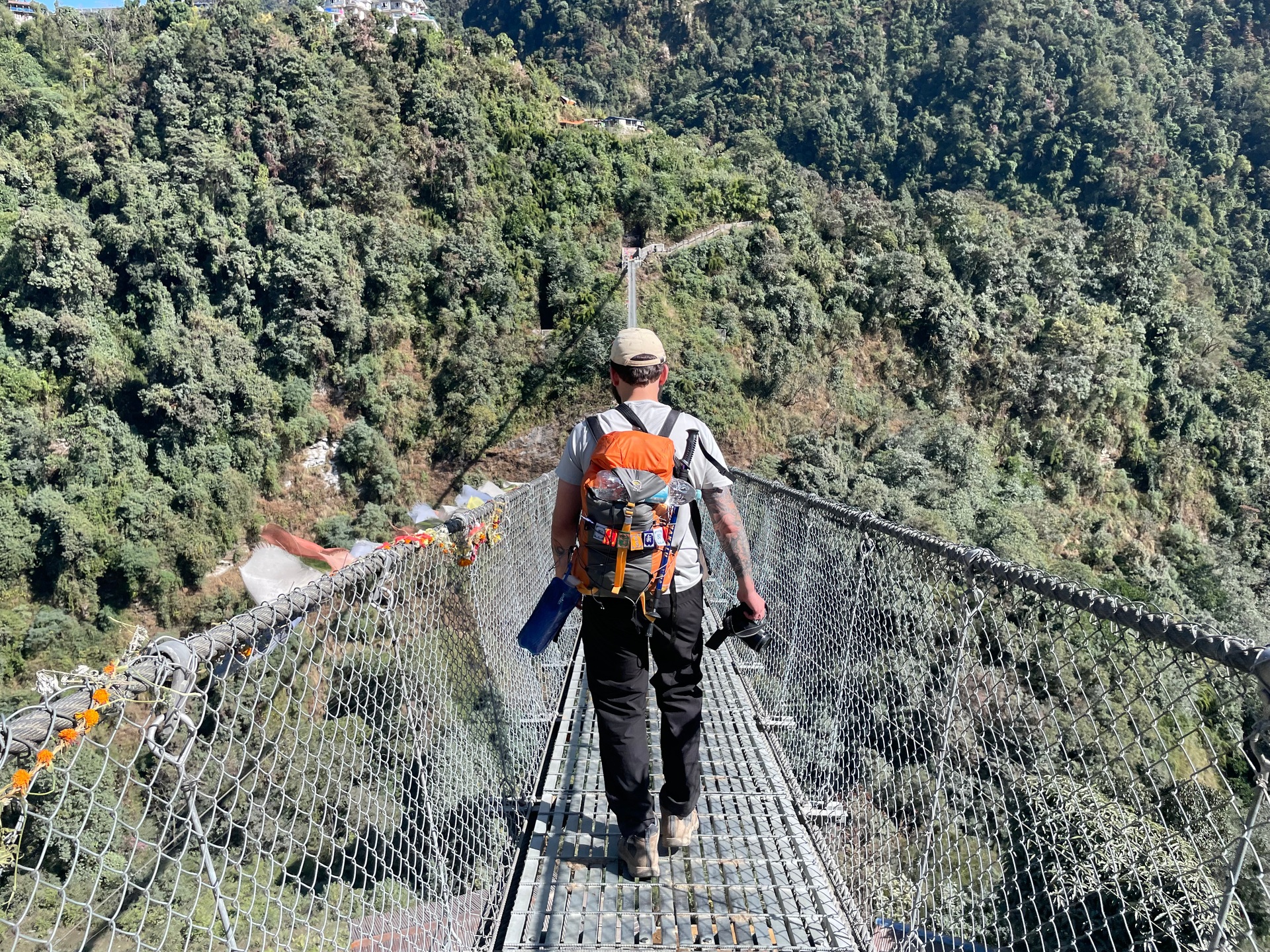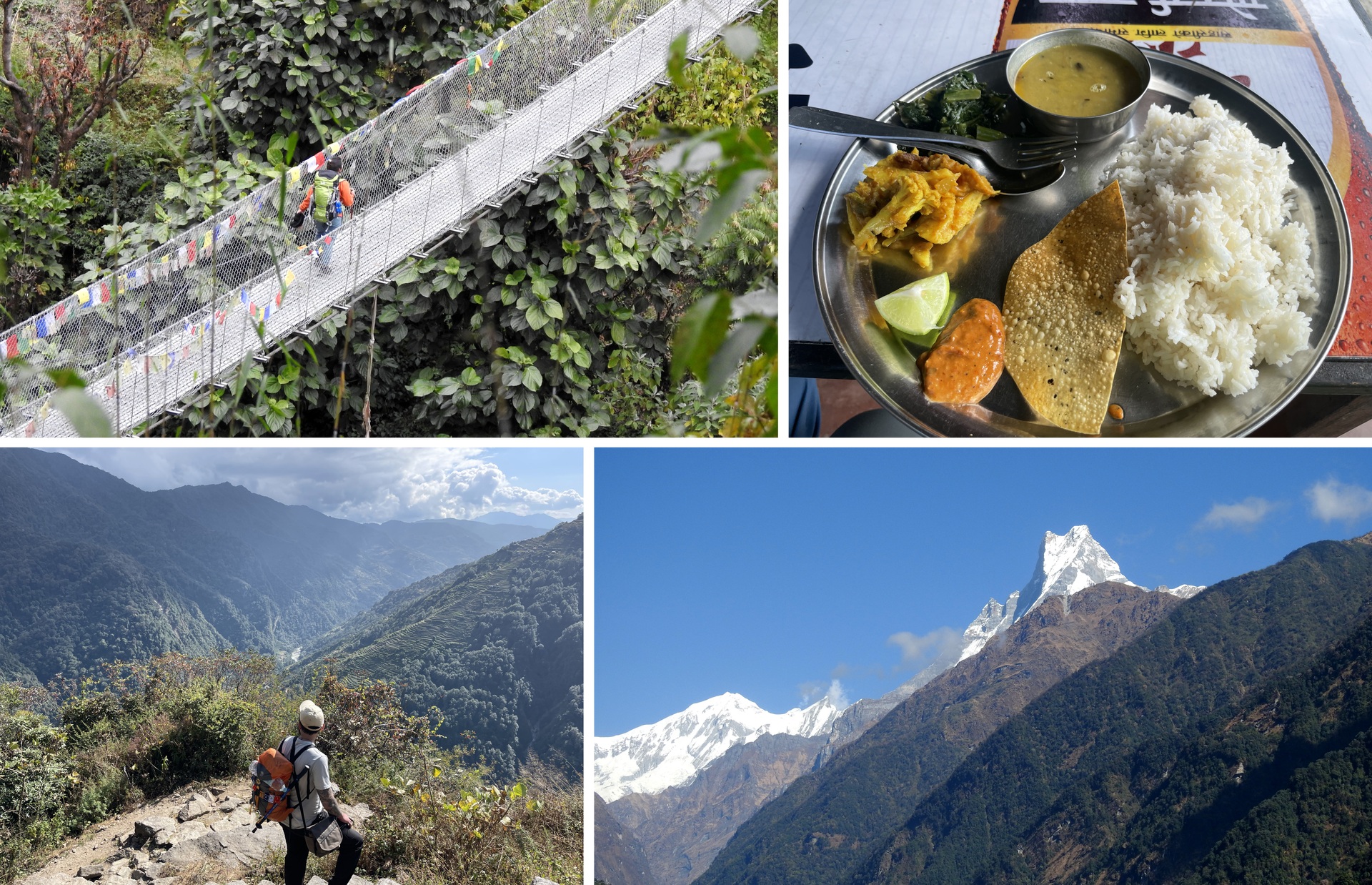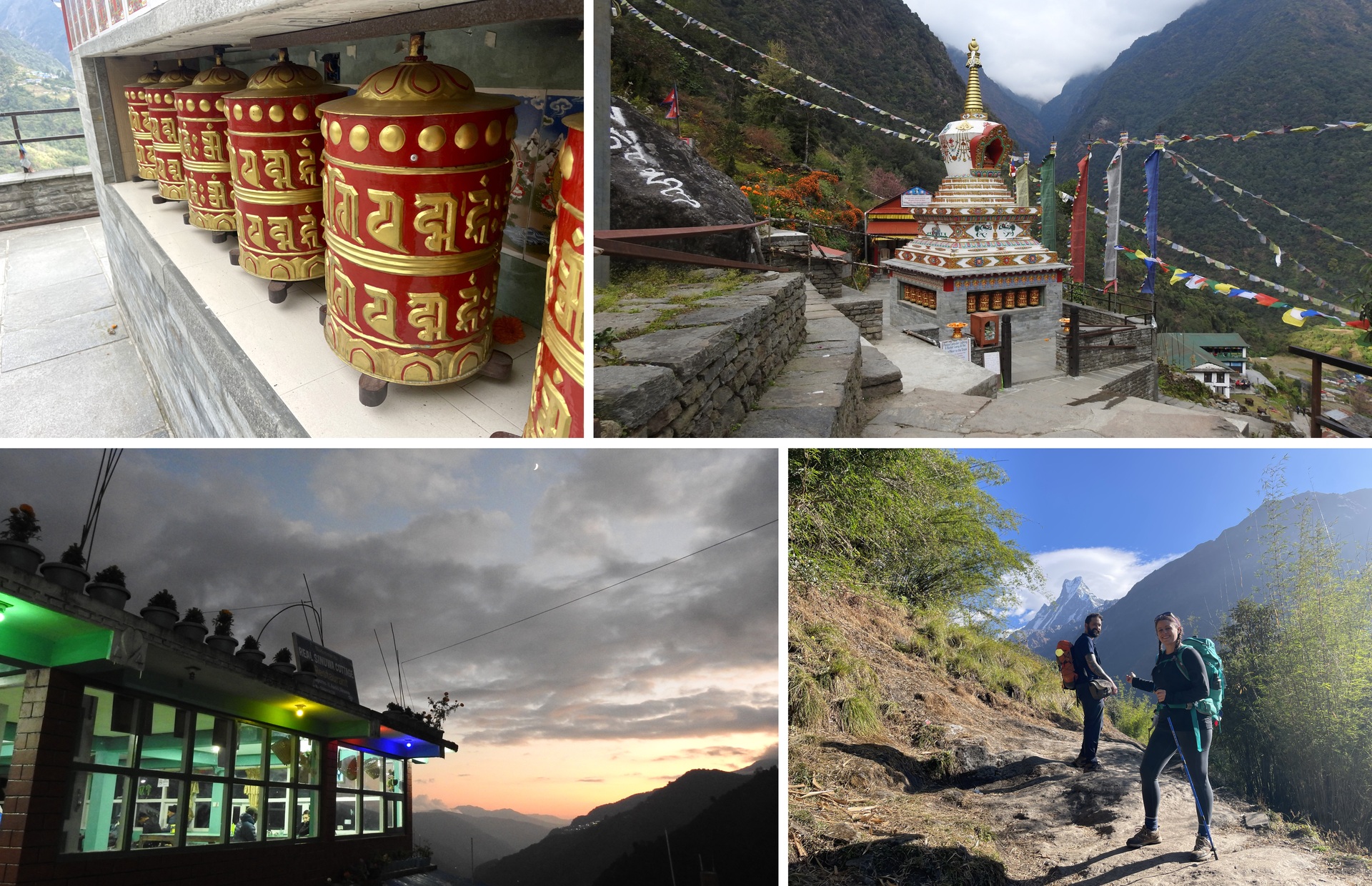“The beginning is the most important part of the work.”
-Plato

It's marked on my map as "New Bridge," and it feels like it's at least a kilometer long (it isn’t: it’s actually less than 300 meters, which is, frankly, plenty long for me). Buddhist prayer flags and scarves are tied securely to its metal ropes, whipping back and forth in the stiff breeze that buffets the Modi Khola beneath our feet, turning its turquoise waters to churning foam. That river is pretty far below us now, rushing from the heights of the mountains to cut through the green hills surrounding Jhinu, and it’s a dizzying thing to look down from this vantage point. Better to look straight ahead, I think, concentrating on capturing the jaw-dropping views without letting my camera slip from my hands. Suspension bridges like this one are common in the high places of the Nepal Himalaya, and they’re as picturesque as they are thrilling. I hurry to the other side, where there’s plenty of time to enjoy the scenery, and I crane my neck to the sky. The natural wilderness here is nothing short of miraculous: I’m treated to the sight of conical green hillsides layered across white mountains of startling size, their ice-laden peaks arcing across a perfect blue sky. But it's actually something else that captures my eye and demands my attention: the path ahead.
Stairs, stairs, and more stairs: this is the trail switchbacking steeply between Jhinu Danda and Chhomrong. It's a clear day, and the Himalayan sun beats mercilessly upon the back of my neck as I hunch beneath the weight of my trekking pack, climbing higher and higher into the mountains with one labored step after another. It’s been more than a year since I’ve hiked in the Himalayas, and I find myself relearning the proverbial ABCs of trekking as we ascend to Chhomrong. “Bistārī, bistārī,” Hari cautions us: slowly, slowly. “Pole, pole,” we respond in turn: the very same sentiment, expressed in Swahili. Hari cackles in delight; he recognizes the phrase, having hosted trekkers from around the world. For the rest of the day, both expressions become a kind of refrain among our little group, reminding each of us to take our time. The mountains are patient, and they’ll be there when we arrive. And the clear day comes with its own rewards: it's hard to imagine Himalayan views more promising than these. As we ascend to Chhomrong, the iconic fishtail-summit of Machapuchare boldly reveals itself, along with the more distant masses of Gangapurna and Annapurna I.
Along the way, we meet up with a 20-something couple from Kathmandu who are trekking to the beat of their own music, cranking from the surprisingly capable speakers of a mobile phone. This is to prove a common phenomenon during our time on the trail, particularly with regard to Nepali trekkers: we’re treated to classic songs from Nepal, popular Bollywood showtunes, and—unexpectedly—American rock music from the early 2000s. It’s the lattermost that this young couple is enjoying on the long way to Chhomrong. For a few minutes, we all sing along together to a song by System of a Down. We chat about the music and where it comes from, and I mention that I've had the pleasure of seeing the band play live about 15 or 20 years ago. "I was just a little kid back then," says one of our new trekking buddies. That rather puts things in perspective, I think to myself. I press on, hiking beyond the range of their music, just as though I can outpace my own age.

Eventually, we find ourselves pulling into the lovely village of Chhomrong. We won’t be staying here overnight; it’s just a quick stop for lunch on today’s agenda. I order vegetarian momos: steamed dumplings packed with cabbage, carrots, and onions and served with a spicy sauce. This is my favorite dish in the Himalayas, and I’ve enjoyed seeing many regional variations to the recipe during the course of my travels in this part of the world. Krista orders stir-fried noodles; Hari and Sangkhar opt for something a little more traditional. There's a trekker's maxim that's as well-known in this part of the world as any turn of phrase: “Dal Bhat Power, 24 Hour.” This refers, of course, to the ubiquitous rice-and-dal dish of the Nepal Himalayas, known for its hearty flavors and energy-lending properties. Hari cites this to me as he announces what he and Sangkhar will be having for lunch. But have you heard the coda to this famous refrain? "1-Hour Toilet, No Shower." Or so Hari would have me believe—and it does have something of the ring of prophecy about it. I laugh, but I'm hoping it doesn't turn out to be predictive of my own future.
With full bellies and limbs bursting with renewed vigor, we step away from our lunch table and set off downhill through Chhomrong. This is a spectacularly charming little village full of terraced fields, humble homes, and friendly folks ready with a welcoming wave. It would turn out to be one of my favorite stops on the Annapurna Base Camp Trek, and we wonder whether it might be possible to spend more time here on the return journey. Part of Chhomrong’s appeal can undoubtedly be attributed to its Buddhist stupa, or chorten, that was installed in 2017. These classic Himalayan monuments derive from the basic burial mound, and their design symbolizes both the proportions of the Buddha and the elements of the earth, culminating in the sun-and-moon motif which adorns their topmost spire. Chhomrong’s stupa is unusually ornate in comparison to some of the simpler whitewashed chortens I've seen elsewhere in the Himalayas, and we are encouraged to make a small donation and light a butter lamp to pay our respects. Only too happy to oblige, I trace my hand along a row of prayer wheels recessed in the structure’s base, setting them into motion and sending the mantra om mani padme hum revolving over and over as the wheels spin. Lighting a butter lamp is more challenging: the lighter is troublesome, the wicks reluctant to catch its spark. But I persist; seeing the flame sputter to life is its own reward, and lighting these little lamps is believed to dispel ignorance: a core tenet of Tibetan Buddhism.
A large group of European trekkers approaches as we leave the stupa behind, gaining ground and coming up hot on our heels just as we pull aside to allow a train of donkeys to pass (side note: if you’re ever moving aside for donkeys, horses, or yaks, be sure not to get trapped against the animals and a cliff). Watching as our fellow travelers blow past the stupa with nary a second glance, I wonder if they are in a hurry. Pole, pole, I think to myself with a smile.

Leaving Chhomrong behind, we now move down through terraced fields of rice, beans, and millet. This leg of the trek is the antithesis of everything we've done in the early afternoon. There are still plenty of stairs, to be sure, but now we're on the descent. It's not long before my tired runner's knees begin to tremble with the strain, even with the support of a trekking pole: a last-minute buy in Pokhara. But the staircases lead inexorably down to another, smaller suspension bridge, where I get a bit of a reprieve from the descent. A quick jaunt across the bridge’s shaking planks (Hari dances a mock-drunken jig as we hold on for dear life) brings us to—wait for it—another staircase. It's back to climbing from here, and our destination is now firmly in sight: Sinuwa. This sprawling mountainside village is actually split into Lower Sinuwa and Upper Sinuwa, with a bit of a hike between the two. We've chosen to stay in Lower Sinuwa for our first night on the Annapurna Base Camp Trek.
Glancing behind us, we see that the large group of European trekkers is rapidly approaching once again. Despite our mounting exhaustion, we put on a burst of speed: we've got to secure a room and a shower before all the hot water runs out! Nevertheless, the going is steep, and each of our groups takes turns passing the other, exchanging rueful grins as we encounter one another again and again on the steep ascent to Sinuwa. Our good-natured race continues for 20 or 30 minutes—but at long last, after about five total hours of trekking, we reach our first guesthouse on the Annapurna Base Camp Trek: the Real Sinuwa Cottage and Restaurant. Waiting for us now are hot showers, good food, cold beer, and an entrancing Himalayan sunset. This will prove to be one of my favorite features of the trekking in Nepal: as the burning ball of the sun sinks below the horizon behind a veil of clouds, it transforms the clear blue sky into an unlikely blaze of pinks and purples before ceding finally to darkness.
When you’re on the Annapurna Base Camp Trek, you’ll be staying in small lodges known as guesthouses or teahouses. You can expect simple, clean rooms, comfortable beds, and wonderful mountain settings. Teahouse accommodations are usually quite inexpensive, with the understanding that you’ll take your meals where you’re staying. The Real Sinuwa Cottage and Restaurant is no exception, and tonight we enjoy a hearty dinner of vegetarian noodle soup and dal bhat to celebrate our first day on the trail.
After dinner, we break out a bottle of AMS Himalayan whisky that I picked up in Pokhara. I’m equal parts amused and alarmed at its name, which appears to be inspired by the clinical term for altitude sickness: acute mountain sickness, or AMS. Hoping it’s not a portent of things to come, I pour a couple fingers into my glass and break out a deck of cards. Attracted by the latter like sharks to fresh blood, Hari and Sangkhar come running over to teach us how to play dhumbal. This is a popular Nepali card game where each player maintains a hand of no more than five cards, and the objective is to eliminate cards from your hand by stringing together pairs or sequences of cards and laying them down on the table. The winner finishes with the lowest number of points. It’s simple, fast, and funny—and makes for the perfect nightcap to our first day on the trail.




Planning a Trip to Nepal? Make an Inquiry